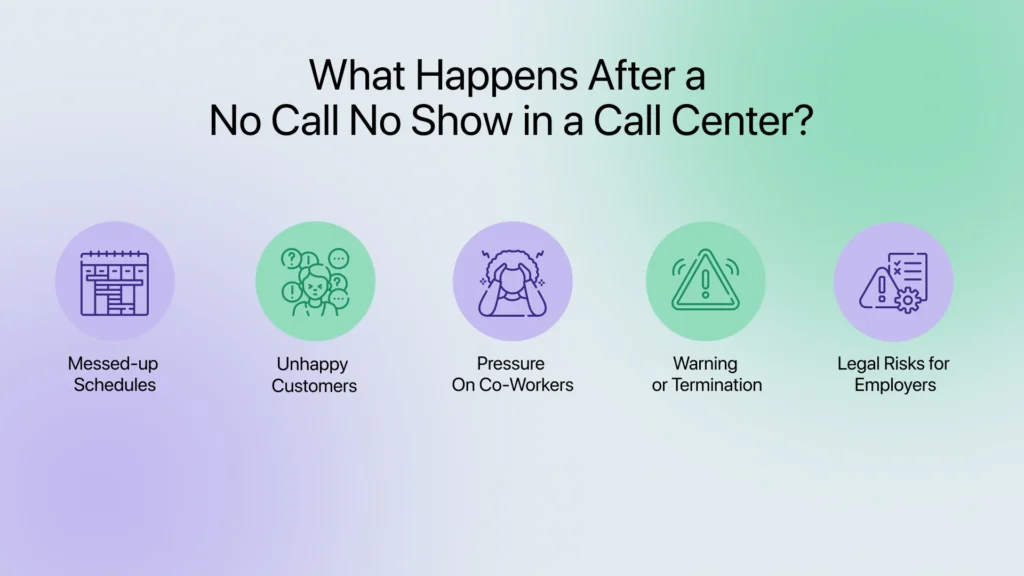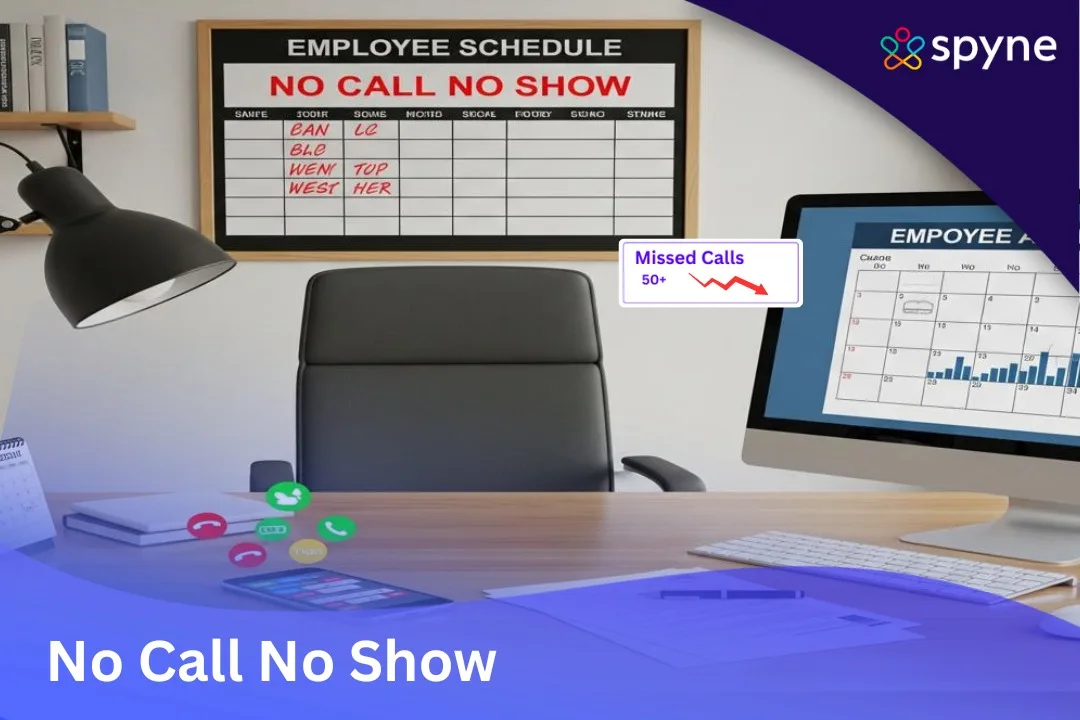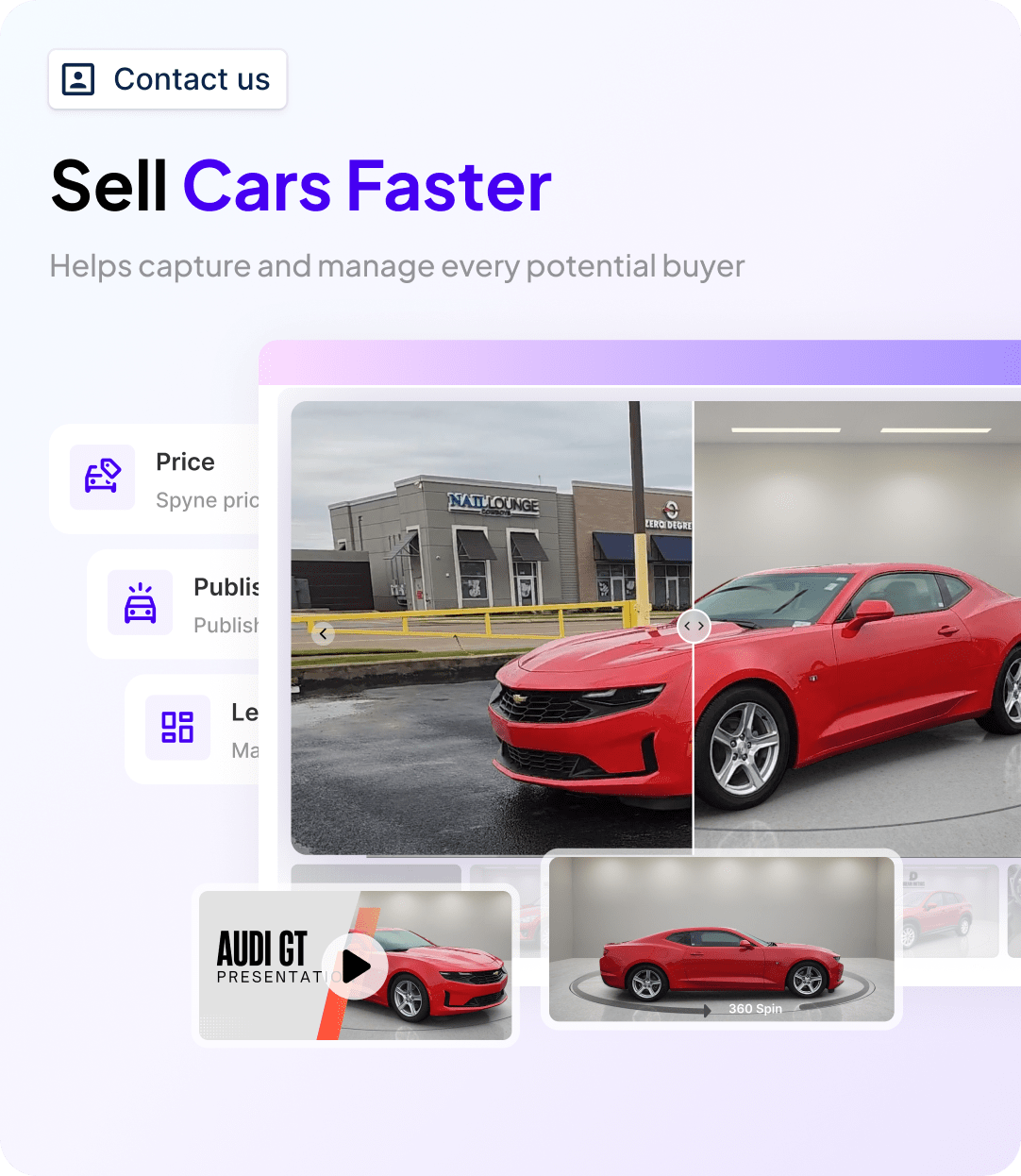When someone doesn’t show up to work and doesn’t even bother to call, it throws everything off. Whether you’re managing a support team or handling customer service at a fast-paced business, every person matters. One no call no show can lead to missed calls, unhappy clients, and coworkers scrambling to fill in. That’s why having a clear plan in place is so important. In this blog, we’ll break down what NCNS actually means, why it causes so many headaches, how to deal with it better, and how Spyne can help when your team is short-staffed.
What does No Call No Show (NCNS) Mean?
NCNS stands for No Call No Show. It describes a situation where an employee no call no show happens, meaning the person misses their scheduled shift without informing their manager, supervisor, or employer in advance. This means they neither show up for work nor contact anyone to explain why they’re absent.
In most workplaces, especially in BPOs and call centers, an employee no call no show can hurt productivity and service levels. That’s why many companies have a no call no show policy that clearly explains how such cases are managed.
There are no federal rules about NCNS, but state laws, like no call no show California guidelines, may allow sick leave or emergency time off without prior notice. Still, repeated cases often lead to a no call no show write up or even termination for no call no show.
The NCNS meaning in work settings is simple: no notice, no show. It is treated as a serious issue, which is why businesses often enforce a strict no call no show for work policy.
What Happens After a No Call No Show in a Call Center?
In a call center, when someone has a no call no show at work, it creates serious issues for the entire team. These workplaces run on tight schedules, and every person matters. Even a single no call no show for work can disrupt operations and hurt performance.
1. Messed-up Schedules
If an employee no call no show happens, the team becomes short-staffed. Other employees have to cover by taking extra calls, and managers must adjust schedules. This impacts daily productivity and increases stress.
2. Unhappy Customers
With fewer people answering calls, customers have to wait longer. Some may get frustrated or hang up. This affects customer satisfaction and can hurt the company’s reputation. To handle this, many businesses use call overflow solutions to make sure calls don’t go unanswered when staff is short.
3. Pressure on Co-workers
When one person doesn’t show up, the rest of the team has to take on more work. Over time, this becomes tiring and stressful for everyone. It can also lead to frustration among team members.

4. Warning or Termination
Most companies have a no call no show policy. If an employee violates it, they usually get a no call no show write-up. Repeated cases often lead to termination for no call no show. Some businesses also use strategies like call diversion to ensure calls are still handled when staff is unexpectedly absent.
5. Legal Risks for Employers
Sometimes employees have genuine emergencies or illness. In states like California, labor laws protect workers in such cases. Employers need to balance their no call no show policy with compliance.
What are the Simple Ways to Reduce No Call No Show in a Call Center
No call no show issues can throw the whole team off. But with a few simple changes, managers can reduce how often it happens.
1. Set clear rules
Start with a no call no show policy that everyone understands. Explain how to report time off, who to contact, and what happens if someone skips a shift without notice. Keep the rules simple and visible.
2. Give people some flexibility
Life doesn’t always go as planned. Allowing employees to swap shifts or request time off easily reduces employee no call no show cases.
3. Make it easy to reach out
Sometimes employees don’t know the proper way to inform their manager. Provide simple options like WhatsApp, email, or your HR system so they can check in before it becomes a no call no show for work. Along with messaging tools, some companies also use an AI phone answering service to ensure calls are answered even if a team member is unavailable.
4. Support your team
Employees are less likely to have an NCNS at work if they feel respected and supported. Take time to listen and help when someone is struggling.
5. Appreciate good attendance
Recognize team members who follow attendance rules. A simple thank-you or small reward goes a long way in preventing no show call cases in the future.
What Are Valid Reasons for a No Call No Show?
Skipping work without notice is usually serious, but there are times when it’s not intentional. Sometimes emergencies make it impossible to inform anyone. In these cases, a fair no call no show policy should allow flexibility for genuine situations. Here are examples where an employee no call no show might be considered valid:
1. Sudden Health Problems
If someone ends up in the hospital or has a serious health scare, contacting work may not be possible. These cases can result in a no call no show write up even when it’s beyond their control. Tools like call monitoring software help track missed communication attempts, so managers can verify what really happened.
2. Family Situations That Need Immediate Attention
Accidents or illnesses involving family members often leave employees overwhelmed. In such cases, missing work without making a no show call is sometimes unavoidable.
3. Unexpected Accidents on the Way
Car accidents or injuries during a commute can prevent employees from calling in. This is one reason why termination for no call no show should always consider circumstances.
4. Major Travel Problems
If public transport fails or a car breaks down in a remote area, even sending a message might be impossible. An updated no call no show write up template should account for such rare cases
5. Severe Weather or Natural Disasters
Storms, flooding, or outages can make communication difficult. A good no call no show policy should make allowances for these events.
6. Loss of a Loved One
Grief can be overwhelming, and making a no call no show for work notification isn’t always the first thought during such emotional moments.
7. Emotional or Mental Overload
Anxiety or severe stress can make employees shut down completely. Companies recognizing this in their employee no call no show policy show empathy and build trust.
8. Couldn’t Get Through
Sometimes, it’s not the person, it’s the tech. Dead phones, poor signal, or system errors can stop messages from going through. This is rare, but it does happen.
Why Having a No Call No Show Policy Actually Matters
A no call no show might look like one missed shift, but in a call center or BPO, it can disrupt the entire workflow. Teams get stressed, managers scramble to cover, and customer experience suffers when calls go unanswered. That’s why every company should have a clear no call no show policy to keep things fair and organized.
1. It Keeps Things Fair for Everyone
When an employee no call no show happens in businesses offering call center services, other team members pick up extra work.
2. It Saves Time and Money
No-shows often lead to overtime, missed targets, or temporary hires, all of which cost money. A strong no call no show policy helps reduce those surprise expenses by discouraging last-minute absences.
3. It Encourages Accountability
When expectations are clear, people tend to take their shifts more seriously. A no show isn’t just shrugged off; there are rules in place. That way, if someone doesn’t follow through, you’re not stuck guessing what to do next. You just follow the policy.
4. It Protects the Company
States like California have specific labor laws that cover emergencies and sick leave. A written policy helps your company stay consistent and legal, especially if you ever have to issue a no call no show write-up template or sample for documentation.
5. It Builds a More Reliable Team
When employees know they’re all held to the same standard, it builds trust. Everyone knows what’s expected and what happens if someone doesn’t show up. That sense of structure helps morale and reduces no call no show for work incidents.
How to Make a No Call No Show Policy That Actually Works
If people are missing shifts without telling anyone, it’s going to cause problems. It throws off the schedule, puts pressure on other team members, and honestly, it’s just frustrating for everyone. That’s why having a clear no call no show policy is important, not just to lay down rules but to help everyone understand what’s expected when it comes to employee no call no show situations.
1. Be Clear on Why You’re Doing This
Start by explaining why the policy exists. It’s not about punishing people. It’s about keeping things fair, making sure work gets done, and helping the whole team stay on track.
2. Spell Out What Counts as “No Call No Show”
Make sure everyone knows what qualifies. For example, if someone doesn’t show up and doesn’t call or message before their shift starts, that’s a no call no show at work. Even if it happens once, it’s worth talking about.
3. Tell People How to Reach Out
Give them a few simple ways to let you know they’ll be out. Text, email, WhatsApp, chat software, or a phone call whatever works best. Just make sure they know who to message and how early to do it. Saying “at least 30 minutes before your shift” keeps it easy to remember and helps avoid ncns meaning in work issues.
4. Lay Out What Happens If They Don’t Follow It
This part matters. If someone misses work without saying anything, what are the next steps? You can start with a verbal reminder. If it keeps happening, maybe a written note or a formal no call no show write-up. After that, it could lead to termination for no call no show. Be honest about it, but not harsh.
5. Make Room for Real Emergencies
Sometimes people genuinely can’t call, like if they’re in the hospital, stuck in a serious situation, or there’s been a death in the family. Make sure your policy leaves space for that. And let people know that once they’re able, they should still reach out.
6. Share It Properly
Don’t just bury the policy in a long handbook no one reads. Go over it during training. Put it somewhere easy to find. And talk about it with new team members so there’s no confusion later.
7. Keep It Flexible and Update When Needed
Things change. Your team might grow, tools might change, or you might learn that part of the policy just isn’t working well. Don’t be afraid to tweak it over time. Using task management software can make updates and communication easier so everyone stays aligned.
8. Double-Check It Follows the Rules
Especially if you’re in states like California, make sure the policy lines up with any local laws about sick leave, emergencies, and time off. It’s a good idea to run it by someone who knows HR or employment law before finalizing your no call no show policy template.
How to Put a No Call No Show Policy into Action
Once you’ve written a clear no call no show policy, the next step is making sure it actually works in real life. A policy on paper doesn’t mean much unless your team knows it, understands it, and sees it being used fairly. Here’s how to roll it out the right way:
1. Talk About It from Day One
Start during onboarding. When new people join, make sure they know what counts as a no call no show at work and what’s expected. Keep it simple. Don’t just hand them a document walk them through it. Make space for questions so it’s clear from the start.
2. Keep the Rules Visible
Remind your team now and then. A quick refresher during a team meeting or posting the basics in your employee portal can help. People are busy, so it’s okay to repeat the important stuff. You can also mention available support tools like an AI call bot to handle routine calls when someone is absent, reducing the impact of NCNS cases.
3. Be Clear About the Consequences
Let everyone know what will happen if someone skips work without notice. Whether it’s a verbal warning, a no call no show write-up, or something more serious like suspension or termination for no call no show, it should never feel like a surprise.
4. Apply the Rules Fairly
This is a big one. Make sure everyone is treated the same, no matter what their role is. If one person gets a pass and someone else gets written up, it can really damage team morale and cause confusion about what NCNS means in work settings.
5. Be Open to Feedback
Policies work better when people feel heard. If someone has concerns or if something feels unfair, be open to talking about it. You might learn that a part of the process needs adjusting. This makes your no call no show policy template more practical and employee-friendly.
How to Handle No Call No Show in a Call Center
Dealing with no call no show (NCNS) cases in a call center can be stressful. But with the right approach, you can keep things under control and avoid bigger issues. Some companies even consider call center outsourcing as a backup solution to manage workload when staffing becomes unpredictable. Here’s how to make it easier for your team and maintain smooth operations:
1. Use a time tracking system
A good attendance tracking tool makes it easy to spot employee no call no show cases. Most call centers use apps or software to track shifts and avoid confusion later. Combine this with automated outbound calling to notify backup staff or inform supervisors instantly when someone doesn’t show up.
2. Make it easy for people to reach out
Provide simple ways for employees to inform you WhatsApp, Slack, email, or even a quick call. If contacting a manager is easy, there’s less chance of a no call no show at work.
3. Build a culture where people feel comfortable
When employees feel judged or ignored, they’re more likely to stay silent. Create an environment where people feel comfortable sharing issues before they miss work. This reduces ncns in BPO scenarios significantly.
4. Recognize those who show up
Reward employees who consistently show up. A shout-out, small perk, or day off can encourage good attendance and prevent repeated NCNS cases. Some businesses even use tools like an AI sales assistant to keep processes running smoothly and maintain engagement when staff are unavailable.
5. Keep track of everything
If someone skips work without notice, record the details: date, attempts to contact, and any response. Documentation is important for no call no show write-up steps later.
6. Talk to the person before deciding what to do
Once the employee returns, find out what happened. If it was an emergency, be understanding. But if it’s frequent, follow your no call no show policy and apply fair consequences like a warning or write-up for no call no show.
7. Don’t overload the rest of the team
It’s not fair to make others do double the work every time someone’s missing. Train your team in multiple areas so people can fill in if needed. And if possible, have a backup person on call during peak hours. You can also use call routing to automatically redirect customer calls to available agents, reducing pressure on the team.
8. Check and update your policy from time to time
As your call center grows, your NCNS policy might need updates. Review it regularly and make sure everyone knows the rules for handling NCNS meaning in call centers. Using tools like contact management software also helps you maintain updated employee and client details, making communication easier.
How Spyne Helps Your Dealership Tackle NCNS Problems
When a team member doesn’t show up without notice, your dealership operations can quickly take a hit missed calls, delayed follow-ups, and lost leads. Employee no call no show situations are common in fast-moving environments like BPOs and call centers, and they can severely affect workflow. Spyne helps you fill that gap, keep track of everything, and stay connected with customers, even when short-staffed.
1. AI Callbot That Works 24/7
Spyne’s AI callbot for car dealerships picks up calls any time of day, even during a no call no show at work. It answers basic questions, books test drives, and collects lead info, so no opportunity is lost when someone misses a shift.
2. Real-Time Call Tracking
You’ll know exactly which calls came in, who answered, and who didn’t. If a staff member didn’t show up, you can instantly reroute calls and assign leads to someone else no delays. This helps maintain smooth operations even when there’s a no call no show for work.
3. Lead Follow-Up Done for You
Missed a lead because your rep didn’t show up? Spyne automatically follows up via text or call reminders. This way, your dealership never goes silent even when someone is absent. It’s the best solution for NCNS meaning in BPO scenarios where consistency matters.
4. AI Lead Scoring That Shows Who’s Ready to Buy
Spyne’s AI lead scoring for car dealerships track customers actions like website visits, call engagement, and listing views to calculate how likely they are to make a purchase. It gives your team a percentage-based score, so you can see which leads have the highest chance of converting and close deals faster despite no call no show consequences.
5. Lead Tags That Tell You Who’s Hot, Warm, or Cold
Each lead is tagged as hot, warm, or cold, depending on their activity. These simple tags help your sales team quickly understand who’s ready to talk, who needs a little more time, and who’s not interested. It’s an easy way to stay organized when dealing with employee no call no show write up situations.
6. Central Dashboard to Track Who’s Active
See who’s working and who isn’t all from one screen. If a rep goes missing without notice, you’ll know right away and can take action fast. This feature helps reduce stress caused by frequent ncns issues.
7. Auto-Routing Leads to Available Reps
When a team member is absent, Spyne sends incoming leads to someone who’s available, acting almost like a virtual sales assistant that ensures no lead is missed.
8. Appointment Reminders and Confirmations
Spyne automatically confirms test drives or service appointments. Even if a team member is absent, the customer is still updated, and your calendar stays full. This reduces no call no show consequences on customer experience.
9. Keeps the Sales Team on Track
No matter what happens, Spyne helps your team stay productive. It reduces the pressure of no shows and makes sure your dealership doesn’t miss a beat even if termination for no call no show becomes necessary later.
Conclusion
No call no shows are frustrating. They create stress, slow down operations, and hurt your customer experience. But with a clear NCNS policy, open communication, and the right tools in place, you can reduce how often it happens and handle it better when it does. And if you’re tired of leads falling through the cracks when someone misses a shift, Spyne’s AI-powered solutions have your back. From 24/7 call handling to smart lead scoring and auto-routing, it helps keep your sales process running smoothly, even when your team hits a snag. Ready to stop losing leads to missed shifts? Book a free demo and see how Spyne can help.
















